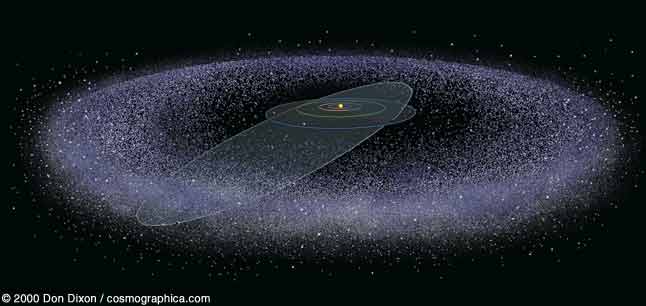| Topic: New dwarf planet hints at giant world far beyond Pluto | |
|---|---|
|
Edited by
mightymoe
on
Wed 03/26/14 06:45 PM
|
|
|
Dwarf planet
� Scott S. Sheppard, Carnegie Institution for Science 
Three images, showing dwarf planet 2012 VP113 in red, then green, then blue, were combined to reveal its path across the night sky. A surprise monster may be lurking in our solar system. A newly discovered dwarf planet has grabbed the crown as the most distant known object in our solar system - and its orbit hints at a giant, unseen rocky world, 10 times the mass of Earth and orbiting far beyond Pluto. The dwarf planet, for now dubbed 2012 VP113 because it was spotted in images taken in November 2012 - is an interesting discovery in itself. Scott Sheppard of the Carnegie Institution for Science in Washington DC and his colleagues found that it is a lump of rock and ice 450 kilometres wide and lies at 80 astronomical units from the sun at its closest approach (1 AU is Earth's distance from the sun). That's twice as far as the most famous dwarf planet, Pluto, which is 2340 kilometres wide and also beats the previous record holder, a 1000-kilometre-wide planetoid called Sedna, discovered in 2003, with a closest approach of 76 AU out. Objects orbiting this far from the sun, in the "inner Oort cloud", are useful to probe the early solar system. That's because they lie too far away to be perturbed by the gas planets, but too close to the sun to be affected by the gravity of other stars in our galaxy - so their orbits and behaviour are thought to be almost unchanged since they first formed. "Once we find more objects in this region, we'll be able to start to strongly constrain the possible formation scenarios," says Sheppard. Distant puppeteer The discovery of 2012 VP113 instantly doubles the number of objects known in this part of space, from 1 to 2 - and the team estimates that many more exist in this region and are just waiting to be discovered. "We thought Pluto was unique for over 70 years, but we now know that it shares its orbit with thousands of other objects," says Sheppard. "Sedna was unique for about 10 years but it's now clear that Sedna and 2012 VP113 are just the tip of the iceberg." Intriguingly, Sheppard's team also found a strange alignment when they looked at the orbits of 2012 VP113, Sedna and 10 other objects that lie closer to the sun. "It was a big surprise to us," he says. One explanation for the alignment could be the tug of a rocky planet that is 10 times the mass of Earth that orbits the sun at 250 AU, the team calculate. That world would be cold and faint - and would push and pull at the closer objects like a distant but powerful puppeteer. Orbit of possible new planet � New Scientist NASA's Wide-field Infrared Survey Explorer (WISE) scoured this region of space in 2010 and 2011 searching for a so-called Planet X and came up empty. However, WISE was looking for the tell-tale warmth of gas giants - a rocky "super-Earth", like the one Sheppard's team suggest, would be too cold for the telescope to pick up. "This is too faint for WISE," says Ned Wright, the space telescope's principal investigator. Even if the planet has a small internal heat source - and absorbs some sunlight, it would still not generate enough heat to register, he adds. Rogue planets Nonetheless, if it exists, how could such a monster possibly have escaped notice until now? It may seem strange, particularly given our recent ability to spot more than 1000 far more distant planets, in alien solar systems. But instruments such as NASA's Kepler space telescope, which has had particular success in finding such exoplanets, would have no chance of spotting a planet like this one. Kepler is designed to spot tell-tale dips in the brightness of alien stars as planets pass in front of them. "No way would Kepler find this planet," says William Welsh of San Diego State University, a member of the Kepler team. The only method currently available that might have a chance is gravitational microlensing, suggests Welsh, where the gravity of a massive object lying between us and the planet could be used as a cosmic magnifying glass. Recently this method was used to spot an object that might be the first moon glimpsed outside our solar system. However, there are other ways to explain the orbital alignment that Sheppard's team found, including the pull of stars or "rogue" planets kicked out of our solar system eons ago. For that reason, Mike Brown of the California Institute of Technology, a co-discoverer of Sedna, isn't holding out hope of a giant planet just yet. "It is possible that some undiscovered large object out there is doing this, but there are likely many other explanations, too, most of them sadly more mundane." Journal reference: Nature, DOI: 10.1038/nature13156 http://www.newscientist.com/article/dn25301-new-dwarf-planet-hints-at-giant-world-far-beyond-pluto.html#.UzOCP4W9Y-o |
|
|
|
|
|
Edited by
vanaheim
on
Fri 03/28/14 01:23 AM
|
|
|
Way old rehashed news again from the science-journalism community. Not the discovery of 2012 VP113 I mean, but the postulate of a full size planet way out in the Oort cloud.
How old is this news? It dates before Pluto was even discovered, and it relates directly to how Pluto was discovered (and Sedna, and this object). Pluto was discovered because, under the advice of astrophysicists, astronomers began to look for it. Prior to the discovery of Pluto it was tabled in publication that preturbations of Neptune and Uranus could only be caused by another outer planet, one which had not been discovered yet. So astronomers started looking for it and finally found Pluto. Here's the thing. Pluto isn't anywhere near massive enough to cause those preturbations, and the math is quite correct on the preturbations. So absolutely, there has to be another, massive planet out there somewhere. Absolutely, it hasn't been found yet. Absolutely, it has to exist or Neptune and Uranus wouldn't do what they do, that simple. And Sedna, or this new object, they just don't cut the mustard. There is another massive planetary body out there. Or...wait for it...a binary black hole much much farther away (I'm playing jeopardy with this, the question is: if there is a massive planet even at ca.250AU why can't astronomers easily find it? They should be able to...and point 2 is, the primordeal solar disc from which planets are formed doesn't carry heavy elements that far out, that's why everything out that far is basically a cometary body of ice and dust, pluto and sedna and this new one, are just big ones, not massive as in heavy ones, they're light, would float on water, can't preturb ice-giants like Uranus and Neptune, no way, so if there's a massive ie. metallic-rocky planet out there, where did it come from, not our solar disc, not from our solar system, and why can't we see it, the only other mundane possibility is a brown dwarf and that would show up on radio telescopes like a beacon, so again, why can't astronomers find it? Unless...). |
|
|
|
|
|
Way old rehashed news again from the science-journalism community. Not the discovery of 2012 VP113 I mean, but the postulate of a full size planet way out in the Oort cloud. How old is this news? It dates before Pluto was even discovered, and it relates directly to how Pluto was discovered (and Sedna, and this object). Pluto was discovered because, under the advice of astrophysicists, astronomers began to look for it. Prior to the discovery of Pluto it was tabled in publication that perturbations of Neptune and Uranus could only be caused by another outer planet, one which had not been discovered yet. So astronomers started looking for it and finally found Pluto. Here's the thing. Pluto isn't anywhere near massive enough to cause those preturbations, and the math is quite correct on the preturbations. So absolutely, there has to be another, massive planet out there somewhere. Absolutely, it hasn't been found yet. Absolutely, it has to exist or Neptune and Uranus wouldn't do what they do, that simple. And Sedna, or this new object, they just don't cut the mustard. There is another massive planetary body out there. Or...wait for it...a binary black hole much much farther away (I'm playing jeopardy with this, the question is: if there is a massive planet even at ca.250AU why can't astronomers easily find it? They should be able to...and point 2 is, the primordeal solar disc from which planets are formed doesn't carry heavy elements that far out, that's why everything out that far is basically a cometary body of ice and dust, pluto and sedna and this new one, are just big ones, not massive as in heavy ones, they're light, would float on water, can't preturb ice-giants like Uranus and Neptune, no way, so if there's a massive ie. metallic-rocky planet out there, where did it come from, not our solar disc, not from our solar system, and why can't we see it, the only other mundane possibility is a brown dwarf and that would show up on radio telescopes like a beacon, so again, why can't astronomers find it? Unless...). so what causes the perturbations? seems like if there was a giant "Jupiter" somewhere in the ort cloud, it would have it's own little solar system, with all the ice out there... but everything we know of out there orbits the sun, not a planet... 
|
|
|
|
|
|
Saturn's Enceladus moon hides 'great lake' of water.
Just been watching this on the news. How interesting |
|
|
|
|
|
This is more about giant stars, but well worth a watch
http://www.youtube.com/watch?v=6X47B9x670E |
|
|
|
|
|
thank you franky... I'll definitely watch it.. 
|
|
|
|
|
|
Edited by
mightymoe
on
Thu 04/03/14 04:55 PM
|
|
|
you might like this too
http://www.nasa.gov/mission_pages/herschel/news/herschel20130122.html about one of the stars in your video, Betelgeuse |
|
|
|
|
|
Edited by
mightymoe
on
Thu 04/03/14 04:56 PM
|
|
|
thank you franky... i saw brian green do something like this on tv once, where he placed earth as a pea, and canus majoris was the superdome...(a football stadium, here in the states...) |
|
|
|
|
|
Good post. For reasons of gravitational slingshots, rocky bodies can exist in the Ort Cloud. For reasons such as gravitational lensing, Jupiter sized bodies would probably be located fairly quickly in the Ort Cloud too. Large bodies tend to emit radiation such as infra red making them easy to see.
|
|
|
|
|
|
Good post. For reasons of gravitational slingshots, rocky bodies can exist in the Ort Cloud. For reasons such as gravitational lensing, Jupiter sized bodies would probably be located fairly quickly in the Ort Cloud too. Large bodies tend to emit radiation such as infra red making them easy to see. yea, and they've been scanning with infra red telescopes and found nothing... but that could just mean that it's too cool to see with them also... |
|
|
|
|









